
 NETWORKED VIDEO ECOSYSTEM
NETWORKED VIDEO ECOSYSTEM
THE MXNET 1G ECOSYSTEM
QUICK CONNECT GUIDE
AC-MXNET-CBOx MXNet Control Box
The MXNet Ecosystem is an AV-over-IP platform of products that use a traditional networking infrastructure to route video and audio signals throughout large scale systems with unlimited numbers of sources and displays, all switching independently and seamlessly. MXNet also has its own line of Network Switches, pre-configured and optimized for 4K video signals with HDR color, to save you precious onsite installation time.
Installing the devices for MXNet is a very simple and straightforward process. AVPro Edge doesn’t expect AV integrators to get a master’s degree in networking overnight, and they shouldn’t need to! With the MXNet setup process, the IP elements have been removed, allowing AV integrators to configure their setup just as they would with any traditional HDMI matrix switch.
If using a 3rd party network switch with MXNet, please review our Knowledge Base article here.
QUICK CONNECT
FIRST, YOU WILL NEED ONE OF THESE:
NEXT, YOU WILL NEED A MIX OF THESE:
(The AC-MXNET-1G-E and AC-MXNET-1G-D are shown here, but the same steps apply to all models of MXNet 1G Encoders and Decoders.)
FINALLY, YOU WILL NEED ONE OR MORE OF THESE: (depending on system size)
Note: All MXNet switches are preconfigured out-of-the-box for AV over IP applications. True Plug-and Play.
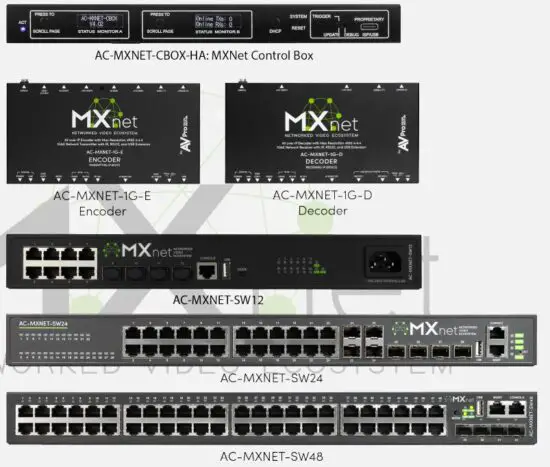
MXNET EVOLUTION II 1G ENCODER/DECODER COMPATIBILITY:
The AC-MXNET-1G-EV2 and AC-MXNET-1G-DV2 devices are part of the EVO II (second-evolution) family and can be used together with MXNet first-evolution Encoders and Decoders in existing or planned systems. However, they must only be used with EVO II Encoder-to-EVO II Decoder pairings and cannot be mixed with first-evolution Encoder/Decoder pairings.
MXNET sw10 CONNECTION DIAGRAM

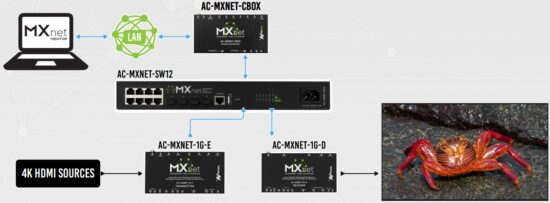
Application Diagram applies to all MXNet 1G Network Switches.
INSTALLATION
- Connect the HDMI source devices to the Encoders.
- Connect the HDMI output devices to the Decoders.
- Connect the power supply to the Network Switch.
- Connect the Encoders and Decoders to the Network Switch (CBOX, Encoders, and Decoders will be powered via PoE)
- Connect the CBOX’s MXnet (PoE) AV NETWORK port to the Network Switch.
- Connect the CBOX’s PORT 1 MENTOR LAN/CONTROL port to your LAN, router, or third-party control system.

- Press the STATUS MONITOR A button on the CBOX until you see the IP address (CBOX is preconfigured out-of-the-box for DHCP).

- Open up a new tab in your web browser and type in the CBOX’s IP address.
- Type in the default username “admin” and password “admin” (all lowercase) to log in.
- Setup and control using the MXNet Mentor web app.
STACKING SWITCHES (only available on the MXNet SW12, SW24 and SW48)
The MXNet SW12, SW24 and SW48 Network Switches can be stacked together by connecting up to four SFP+ ports between the two switches. Each SFP+ port provides 10G uplink between each switch.
An SFP+ link is required per every 10 Encoders; it is recommended to add an additional SFP+ link for system redundancy.
If stacking 3 or more switches together, please contact AVPro Technical Support for further assistance as this requires additional configuration.
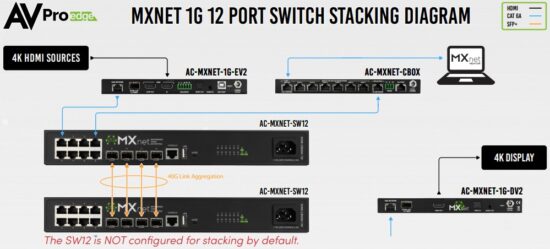
STACKING SWITCHES (only available on the MXNet SW12, SW24 and SW48)
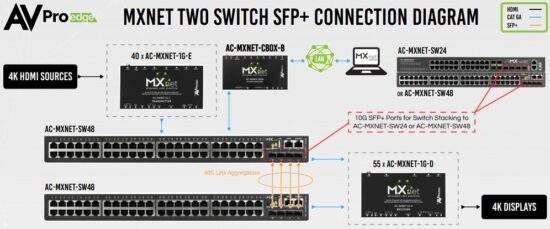
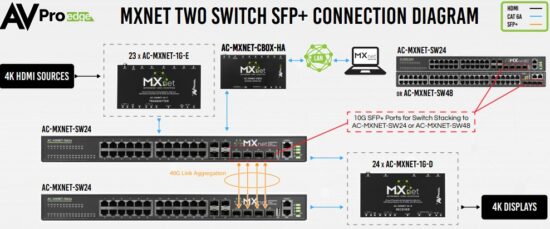
MENTOR
The MXNet Mentor web app comes pre-installed on every CBOX and is a great tool to help you set up, configure, and test with MXNet.
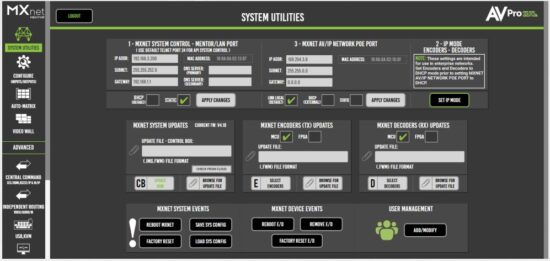
![]() HOME – SYSTEM UTILITIES
HOME – SYSTEM UTILITIES
Once you have successfully logged in, you will be taken to the Mentor home page with SYSTEM UTILITIES. This page shows the IP address for MXNet and the current firmware version on the CBOX. From here, you can update all the MXNet devices to their latest versions of firmware, reboot the CBOX, reboot/remove the Encoders and Decoders, and also factory reset them.

![]() CONFIGURE – INPUTS & OUTPUTS
CONFIGURE – INPUTS & OUTPUTS
This page is where you can configure the Encoders and Decoders, including assign custom names and descriptions (limit of 12 characters), set the input EDID’s and output resolution scaling, adjust the front panel lights, and check the current version of firmware on the encoders and decoders. The System Diagnostics page provides useful information on the speed and quality of the link and signal strength, the video and audio signal coming through, detect and reset HDMI hot-plug events, view HDCP versions, and more.
![]() AUTO-MATRIX – SWITCHING
AUTO-MATRIX – SWITCHING
From here, you can switch your sources and displays just like you would with an HDMI matrix switcher. The sources are located on the left, and the displays are on the right. Simply click on the source first, then click on the display you wish to view it on. You can also save and recall presets on this page for faster switching and preview the sources’ video content as a thumbnail for easy visual reference.

TROUBLESHOOTING
Encoder/Decoder/CBOX not powering up – If all devices are not getting power, verify the power connection on the Network Switch and check the LED indicator lights for each device connection. If only one device isn’t getting power, verify your connection to the Network Switch is appropriate (see examples below).
Verify Connections (device not getting power, video signal dropouts, Mentor shows device with poor network connection, etc.) – Check that all cables are properly connected and not tightly bundled together or exceeding their bend radius.
- Re-terminate using standard RJ-45 connectors. Avoid using push-through or “EZ” type ends, as these have exposed copper wiring at the tips that can damage or bend the pins inside the ports.
- Generally speaking, the higher the video resolution and the longer the run, the better the cabling should be. For most applications, Cat 5e (or better) is recommended with MXNet.
- Swap ports, cables, devices, etc., to help narrow down if the issue stays with the port, cable, or device. Try replicating the issue with a shorter, factory-terminated patch cable closer to the Network Switch.
- If using a third-party network switch, verify its IGMP settings, MTU size, PoE Budget, and EEE functionality are configured correctly. Third-party switch requirements and settings for MXNet can be found here.
Encoder/Decoder not showing up in Mentor – Check the mini-OLED screen on the front panel of the Encoder/Decoder and verify if it shows the MAC address and its current IP address. The IP address (if running default configurations on an MXNet switch) should be a link-local address of 169.254.x.x. If the address is a non-link-local address, and the MXNet switch/CBOX is running default factory configurations (no IP settings changed), please reach out to AVPro Technical Support for further assistance.
Verify EDID’s and Scaling – If you’re having issues with 4K signals, but 1080p is working, verify all the connected devices are capable of the signal you are sending.
- Adjust the output resolution scaling down to a lower resolution, such as 1080p, on a Decoder plugged into a display you’re having issues with. Adjusting the output resolution scaling allows you to simultaneously send 4K signals to the more capable zones, and a lower resolution signal to the non-4K displays, eliminating the need to downgrade the entire system when using a mix of 4k and non-4K displays.
Have a question or need assistance?
Don’t hesitate to contact us!
SUPPORT: +1 605-274-6055
USA TOLL FREE: 877-886-5112
EMAIL: support@avproedge.com
Documents / Resources
 |
AVPro edge AC-MXNET-CBOx MXNet Control Box [pdf] User Guide AC-MXNET-CBOx, AC-MXNET-sw12, AC-MXNET-1g-E, AC-MXNET-1g-d, AC-MXNET-CBOx MXNet Control Box, AC-MXNET-CBOx, MXNet Control Box, Control Box |